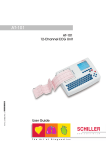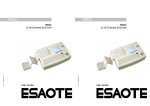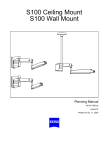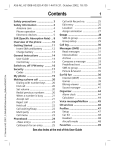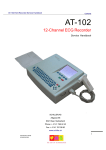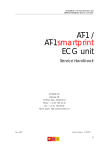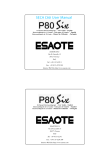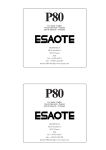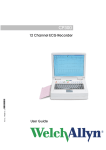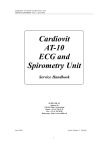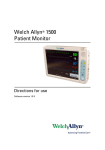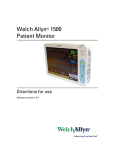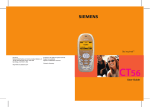Download - Frank`s Hospital Workshop
Transcript
A"-$0$ Art.-no.: 7.5400:; Rev.: a *"#$400'(* A"-$0$ $7-=>annel E=G Devi+e &ervi+e -andboo3 Sales and Service Information The SCHILLER sales and service centre network is world-wide. For the address of your local distributor, contact your nearest SCHILLER subsidiary. In case of difficulty a complete list of all distributors and subsidiaries is provided on our internet site: http://www.schiller.ch. Sales information can also be obtained from: [email protected] Address Headquarters SCHILLER AG Altgasse 68 CH-6341 Baar, Switzerland Web: www.schiller.ch Article no.: 2.540037 Rev.: a Issue date: 08.09.04 Phone: +41 (0) 41 766 42 42 Fax: +41 (0) 41 761 08 80, E-mail: [email protected] A"#$0$ Service Handbook Art.-no.: 2.540037 Rev.: a Contents 1 Safety notes .............................................. 5 1.1 Responsibility of the user ................................................... 5 1.2 Intended use ......................................................................... 5 1.3 Organisational measures..................................................... 5 1.4 Safety-conscious operation ................................................ 6 1.5 Safety facilities ..................................................................... 6 1.6 Operation with other devices .............................................. 6 1.7 Safety Symbols and Pictograms ......................................... 7 1.7.1 1.7.2 Used symbols in this document ......................................................... 7 Used symbols on the device .............................................................. 8 1.8 Terms of Warranty................................................................ 8 2 Introduction .............................................. 9 2.1 Features................................................................................. 9 2.1.1 2.1.2 2.1.3 2.1.4 2.1.5 Standard Features ............................................................................. 9 Optional Features............................................................................... 9 Initiating Functions or Tasks .............................................................. 9 Main Components of the AT-101 ..................................................... 10 Back Panel ....................................................................................... 10 2.2 Keypad................................................................................. 11 2.3 LCD Screen ......................................................................... 13 3 Operation ................................................ 14 3.1 Start-up and Initial Preparation ......................................... 14 3.1.1 3.1.2 3.1.3 3.1.4 3.1.5 3.1.6 Connecting AT-101 .......................................................................... Battery Operation ............................................................................. Switching ON and OFF .................................................................... Isolating the Mains Supply ............................................................... Potential Equalisation....................................................................... LCD contrast adjustment.................................................................. 14 15 15 15 15 15 3.2 Entering the SETUP Menu ................................................. 16 3.2.1 Navigating in the Setup Screens...................................................... 16 3.3 ECG Settings....................................................................... 17 3.3.1 3.3.2 3.3.3 3.3.4 3.3.5 Automatic Format 1 and 2 Internal Printer ....................................... Automatic Format 1 and 2 External Printer ...................................... Filters ............................................................................................... Interpretation (Only with version C).................................................. Leads ............................................................................................... 3.4 General (only with version m X Memory) ......................... 22 4 System Settings ..................................... 23 18 19 20 21 22 4.1 Entering Setup System ...................................................... 23 4.2 Unit....................................................................................... 24 4.3 Communication ................................................................. 25 4.3.1 Setup Transmitting .......................................................................... 26 4.4 Test and Information .......................................................... 27 Page 1 Page 2 Print Setup ....................................................................................... 28 Communications Test ...................................................................... 28 4.5 Software............................................................................... 29 4.5.1 4.5.2 4.5.3 4.5.4 Preparing serial communication for software update....................... Update software .............................................................................. Upgrade to a new option.................................................................. Default Settings................................................................................ 5 Care Z Maintenance ...............................33 5.1 Service Interval ................................................................... 33 5.1.1 Safety notes ..................................................................................... 33 5.2 Functional test .................................................................... 34 5.2.1 5.2.2 5.2.3 5.2.4 5.2.5 5.2.6 5.2.7 5.2.8 5.2.9 5.2.10 5.2.11 5.2.12 5.2.13 5.2.14 Internal Sight Control ....................................................................... External Sight Control ...................................................................... Mains indicator LED test .................................................................. Power Supply test ............................................................................ Keyboard test................................................................................... LCD Screen test............................................................................... Paper Feed ...................................................................................... Printer quality test ............................................................................ Printing Speed ................................................................................. Parallelism test................................................................................. ECG amplifier................................................................................... ECG lead and patient cable test ...................................................... External printer test.......................................................................... Communication (RS-232) Test ........................................................ 5.3 Safety Tests......................................................................... 42 5.3.1 Maximum values safety test............................................................. 42 5.4 Maintenance interval for the battery ................................. 43 5.4.1 5.4.2 5.4.3 5.4.4 Charging the battery ........................................................................ Testing battery ................................................................................. Replacing battery ............................................................................. Battery disposal ............................................................................... 29 30 31 32 34 34 35 35 35 35 36 36 36 37 37 38 41 41 43 43 44 44 5.5 Changing the fuse and mains voltage .............................. 45 5.6 Cleaning............................................................................... 46 5.6.1 5.6.2 5.6.3 Cleaning the Casing......................................................................... 46 Cleaning the Patient Cable .............................................................. 46 Cleaning the Thermal Print Head..................................................... 46 5.7 Printer .................................................................................. 47 5.7.1 5.7.2 5.7.3 Replacing the Recording Paper ....................................................... 47 Thermal Paper Handling .................................................................. 47 Replacing Printer ............................................................................. 48 5.8 Fault-Finding ....................................................................... 49 5.8.1 Accessories and Disposables .......................................................... 50 6 Technical Data ........................................51 6.1 System ................................................................................. 51 6.2 Technical Data for ECG...................................................... 52 6.3 Safety Standards ................................................................ 53 7 Drawing and spare parts ........................54 7.1 Drawings Printer ................................................................. 54 7.1.1 Flap and Drive roll............................................................................ 54 Art.-no.: 2.540037 Rev.: a 4.4.1 4.4.2 Service Handbook 7.1.2 AT-101 pictures................................................................................ 55 7.2 Electrical drawing ............................................................... 57 7.2.1 7.2.2 Power supply.................................................................................... 57 Component layout ............................................................................ 58 8 Appendix ................................................. 59 8.1 Checklist.............................................................................. 59 9 Index ........................................................ 63 Art.-no.: 2.540037 Rev.: a A"#$0$ Page 3 Page 4 Art.-no.: 2.540037 Rev.: a A"#$0$ Service Handbook Safety notes Responsibility of the user 1 1.1 1 Safety notes This Service Handbook is for qualified service personnel only, trained by Schiller AG. Refer to the operating instruction manual 2.510526 for operation the device. 1.1 Responsibility of the user ! ! ! ! 1.2 Intended use ! ! ! 1.3 The AT-101 is a 12-channel, ECG device used for the recording, analysis and evaluation of ECG Recordings. Recordings made with the AT-101 can be used as a diagnostic aid for heart function and heart conditions. The AT-101 is designed for indoor use and can be used for all patients of both sexes, all races, and all ages. Only operate the device in accordance with the specified technical data. Do not use or repair this unit in areas where there is any danger of explosion or in the presence of flammable gases such as anaesthetic agents. Organisational measures ! ! Art.-no.: 2.540037 Rev.: a Specify the competencies of the personnel for operation and repair. Ensure that service personnel have read and understood these service instructions. In particular this section “safety notes" must be read and understood. Have damaged or missing components replaced immediately. The service personnel is responsible for compliance with all applicable accident prevention regulations and safety regulations. ! ! Before servicing the unit, ensure that an introduction regarding the unit functions and the safety precautions has been provided by Schiller AG Keep these service instructions in an accessible place for reference when required. Make sure that they are always complete and legible. Observe the operating instructions and service instructions. These service instructions do not override any statutory or local regulations, or procedures for the prevention of accidents and environmental protection. Page 5 1 1.4 Safety notes Safety-conscious operation 1.4 A"#$0$ Safety-conscious operation ! Do not place any liquids on the unit. If liquid should be spilled over the device, immediately disconnect the device from the mains and wipe it. The device must be serviced before reusing. ! Danger of electric shock! Do not open the device without disconnecting the device from the mains. ! Before cleaning and to isolate the mains power supply, switch the unit off and disconnect it from the mains by removing the plug. ! Do not use high temperature sterilisation processes (such as autoclaving). Do not use E-beam or gamma radiation sterilisation. ! Do not use solvent or abrasive cleaners on either the unit or cable assemblies. ! Do not, under any circumstances, immerse the unit or cable assemblies in liquid. 1.5 Safety facilities ! Operating the device without the correctly rated fuse, or with defective cables, constitutes a danger to life. Therefore: – Do not operate the unit if the earth connection is suspect or if the mains lead is damaged or suspected of being damaged. – Damaged cable connections and connectors must be replaced immediately. – The electrical safety devices, such as fuses, must not be altered. – Ruptured fuses must only be replaced with the same type and rating as the original. Operation with other devices ! Use only accessories and other parts recommended or supplied by SCHILLER AG. Use of other than recommended or supplied parts may result in injury, inaccurate information and/or damage to the unit. ! Ancillary equipment connected to the analogue and/or digital interfaces must be certified according to the respective IEC standards (e.g. IEC/EN 60950 for data processing equipment and IEC/EN 60601-1 for medical equipment). Furthermore all configurations shall comply with the valid version of the system standard IEC/ EN 60601-1-1. Everybody who connects additional equipment to the signal input part or signal output part configures a medical system, and is therefore responsible that the system complies with the requirements of the valid version of the system standard IEC/EN 60601-1-1. If in doubt, consult the technical service department or your local representative. – EC/EN 60601-1-1 states that the patient must remain at least 1.5 meters clear of the unit. If this is not possible, a safety isolating transformer must be installed. Page 6 Art.-no.: 2.540037 Rev.: a 1.6 A"#$0$ Service Handbook Safety notes Safety Symbols and Pictograms 1.7 Safety Symbols and Pictograms 1.7.1 Used symbols in this document 1 1.7 The safety level is classified according ANSI Z535.4. The following overview shows the used safety symbols and pictograms used in this manual. For a direct danger which could lead to severe personal injury or to death. For a possibly dangerous situation, which could lead to heavy bodily injury or to death. For a possibly dangerous situation which could lead to personal injury. This symbol is also used to indicate possible damage to property. For general safety notes as listed in this chapter. Used for electrical dangers, warnings and other notes in regarding operation with electricity. Note For possibly dangerous situations, which could lead to damages to property or system failure. Important or helpful user information Art.-no.: 2.540037 Rev.: a Reference to other guidelines Observe precautions for handling electrostatic sensitive devices Used tool for the following procedure. Page 7 1 1.8 Safety notes Terms of Warranty A"#$0$ 1.7.2 Used symbols on the device Potential equalization CF symbol. This unit is classified safe for internal and external use. However, It is only defibrillation protected when used with the original SCHILLER patient cable! Inappropriate disposal can lead to environmental pollution. Units/components and accessories no longer required can be returned to SCHILLER AG for disposal. Alternatively, the unit should be disposed of in a municipally approved recycling centre. Notified body of the CE certification (TiV P.S.) Attention: Consult accompanying documents. 1.8 Terms of Warranty The SCHILLER AT-101 is warranted against defects in material and manufacture for the duration of one year (as from date of purchase). Excluded from this guarantee is damage caused by an accident or as a result of improper handling. The warranty entitles free replacement of the defective part. Any liability for subsequent damage is excluded. The warranty is void if unauthorized or unqualified persons attempt to make repairs. • assembly operations, extensions, readjustments, modifications, or repairs are carried out by persons authorized by him, and • the SCHILLER AT-101 and approved attached equipment is used in accordance with the manufacturers instructions. Page 8 Art.-no.: 2.540037 Rev.: a In case of a defect, send the apparatus to your dealer or directly to the manufacturer. The manufacturer can only be held responsible for the safety, reliability, and performance of the apparatus if: A"#$0$ Introduction Features Service Handbook 2 2.1 2 Introduction 2.1 Features The SCHILLER AT-101 is a 12-channel ECG unit designed to record, display, and analyse resting ECGs. The unit has been extensively researched to give an ergonomic, clear interface thatks easy to use without compromising functionality. The AT-101 has the following features: 2.1.1 Standard Features • Alphanumeric keypad and dedicated soft key interface for easy, user friendly operation. • Integral thermal quality printer with various user defined print format options. • Measurements and average cycles with automatic and manual printout of the recording. 2.1.2 Optional Features • • • • 2.1.3 External printers ECG Interpretation Memory for up to 40 recordings Thrombolysis Initiating Functions or Tasks Art.-no.: 2.540037 Rev.: a Most functions and tasks are initiated by the 5 softkeys (1) situated immediately below the LCD. The function of the softkeys varies according to the screen displayed and is displayed on the LCD immediately above the key itself. During data acquisition, further dedicated function keys are provided to make an auto mode recording (START) and to stop a manual printout (STOP). The top line of the alphanumeric keypad, additionally enables direct settings of lead group, trace speed and sensitivity, filter on/off and other functions, for both the real-time display and (manual) printout. HR: 78 / min Filter on LEAD TEST MANUAL PRINT MENU 1 Fig. 2.1 Start-up screen Page 9 2 2.1 Introduction Features A"#$0$ 2.1.4 Main Components of the AT-101 (1) (2) (3) (4) LCD Display Softkey control Keypad and dedicated function keys Printer 1 2 3 4 2.1.5 Back Panel (1) (2) (3) (4) (5) Patient cable connector LPT connector for the connection of an external printer RS-232 for connection of a modem or a PC for export of stored recordings Mains connector (with fuse above) Potential equalisation stud 2 1 3 4 5 Page 10 Art.-no.: 2.540037 Rev.: a ! All externally connected hardware must be approved by SCHILLER. Connection of any hardware not approved by SCHILLER is at the ownerks risk. The unit guarantee may also be invalid. See also safety note paragraph 1.6. A"#$0$ Introduction Keypad Service Handbook 2.2 2 2.2 Keypad HR: 78 / min Filter on LEAD TEST 1 MANUAL PRINT 2 MENU 3 Art.-no.: 2.540037 Rev.: a (1) Softkeys - the function of these keys changes depending on the screen displayed. The function of these keys is shown on the screen above the keys. If nothing is written above a softkey, it has no function for the current screen. (2) Auto Mode recording (in Auto mode 1). Press the SHIFT followed by the START key (2) for auto mode 2. (3) STOP printout Page 11 Introduction Keypad 4 17 A"#$0$ 5 6 7 8 9 10 16 11 12 13 15 14 (4) The top figures on the number keys k1kand k2k(designated < and >), change the lead group displayed on the screen, forward and backward resp. (5) Auto sensitivity key - automatically sets the ECG printout sensitivity (in AUTO mode only) to the best setting for the signal strength (5mm/mV or 10mm/mV) (6) The top figures on the number keys designated 5, 10, and 20 set the sensitivity of the ECG both on the screen and on the (manual) printout. The sensitivity is 5, 10 or 20 mm / mV. (7) The top figures on the number keys designated 5/10, 25, and 50 set the speed of the ECG both on the screen and on the (manual) printout. The speed on the screen can only be set to 25 or 50 mm/s. The speed of the manual printout can be 5, 10, 25 or 50 mm/s. The 5 and 10 mm/s settings are both on the same key which toggles the two speeds. (8) Inserts a 1mV reference marker on the screen and printout. Re-centres the trace. (9) Toggles the QRS beeper ON/ OFF (10) Myogram filter ON / OFF. The cutoff frequency can be user defined in kSetupk. (11) Delete last typed character. (12) Patient data key. Press this key to enter a new patient or modify the data for the current one. The patient data screen, or the ECG screen is the first screen displayed on initial switch on. This is set for user preference in the SYSTEM SETTINGS/UNIT (see page 24). (13) ON / OFF Key (14) Mains Indicator - lit when mains connected. (15) Press the function key (16) and the UP/DOWN arrows to adjust screen contrast. When entering patient data use the LEFT/RIGHT arrow keys to move the cursor in the data field. Use the UP/DOWN arrow keys to go up/down to the next data entry (16) Shift key to select capital letters. (17) Function Key. When pressed before another key, initiates the second function of that key. For example, second letters on the keypad -, é, p, ç, r, s, @ etc., are entered by holding the function key before pressing the letter key. Page 12 Art.-no.: 2.540037 Rev.: a 2 2.2 A"#$0$ Introduction LCD Screen Service Handbook 2.3 2 2.3 LCD Screen The display will vary according to the current task being carried out. In all screens however, the top and bottom lines always display the same information: the top line displays system information, and the bottom line always gives the softkey options. The following is an example of a typical resting ECG screen. u 1 HR: 78 / min 4 5 2 6 7 Filter on 8 9 10 3 LEAD TEST MANUAL PRINT MENU Items 1, 2 and 3 are in the same position for all screens. (1) Top line - time, date, patient name, and current power source - mains (u), or battery ( ). When battery capacity is limited the battery symbol flashes. (2) Data acquisition area or data entry area. (3) Softkey designation. Pressing the key below the text carries out the function indicated. The options available will change according to the screen displayed. Art.-no.: 2.540037 Rev.: a Items 4 to 10 are specific for ECG acquisition only: (4) Current Heart Rate (averaged over 4 beats and refreshed every 2 seconds). The HR is also given on a manual printout. Note that with an auto mode printout the HR is averaged over the full 10 seconds of the recording. (5) Electrode connections - when an electrode indication flashes (an audible alarm is also given), it indicates that the electrode resistance is too high. The electrode(s) must be reapplied. (6) Sensitivity 5, 10 or 20 mm/mV. Change the sensitivity with the keys 3 (auto), 4, 5 and 6. An kAk in this box indicates that automatic sensitivity is selected (auto mode printout only). (7) Speed 25 or 50 mm/s. Change the speed with the keys 8 and 9. (8) Lead indication (leads currently displayed on the screen). Change the lead group with the < and > keys on the keypad. (9) 1Myogram Filter indication - kFilter ON’ or kFilter OFF’. The filter is applied with the filter key. (10) Area for system messages or instructions. 1.The frequency of the filter cutoff is defined on page 20 menu Filters. Page 13 3 3.1 Operation Start-up and Initial Preparation A"#$0$ 3 Operation 3.1 Start-up and Initial Preparation ! Danger of electrical shock. Do not operate the unit if the earth connection is suspect or if the mains lead is damaged or suspected of being damaged. Connecting AT-101 (1) (2) (3) (4) Potential equalisation Mains connection (115 or 230 V) RS-232 (see safety note paragraph 1.6) Printer (see safety note paragraph 1.6) Fig. 3.1 1. 2. 5 6 3. 4. 7 Page 14 5. 6. AT-101 back panel Check Voltage setting (2) 115 or 230 V. Refer to chapter 5.5 for the mains voltage. Connect the power cable at the rear of the unit. The mains indicator lamp (6) is always lit when the unit is connected to the mains supply. If the unit is switched on, the relevant symbol is displayed on the LCD (7) Leave the AT-101 connected to the mains for 7 hours to fully charge the battery. Connect the potential equalisation cable and all other necessary cables at the rear of the AT-101. Press the on/off button (5). The patient data or the ECG acquisition screen is displayed (see paragraph 4.2.) Check the settings according to chapters 4. Connect the patient cable on the right side panel. Art.-no.: 2.540037 Rev.: a 3.1.1 A"#$0$ Service Handbook 3.1.2 Operation Start-up and Initial Preparation 3 3.1 Battery Operation Important 1 HR: 78 / min The unit can either be operated from the mains supply or from the built-in rechargeable battery. The power source is indicated on the top line of the LCD. The internal battery provides power for up to 3 hours. • When the unit is running on battery power a battery symbol (1) is displayed. • When working from battery power, the unit is automatically switched off after 5 minutes (30 seconds if battery capacity is limited) if no key is pressed. • for Battery recharging refer to chapter 5.4. • The unit can remain connected to the mains supply without damage to either the battery or the unit. Filter on 3.1.3 Switching ON and OFF " The AT-101 is switched ON and OFF with the ON/OFF key. 3.1.4 Isolating the Mains Supply To isolate the power supply, remove the mains plug from the wall socket. (see Fig. 3.1) 3.1.5 Potential Equalisation Art.-no.: 2.540037 Rev.: a The potential equalisation stud (see Fig. Fig. 3.1) at the rear of the unit can be used to equalise the ground potential of the AT-101 to that of all mains powered equipment in the vicinity. Use the hospital or building common ground ! To prevent the possibility of leakage current when an external printer is connected, always ensure that the mains lead, or the potential equalisation (next to the mains connector), is attached to the AT-101 A yellow/green ground cable for connection to the potential equalisation stud is supplied as an option (Article number 2.310005). 3.1.6 LCD contrast ad`ustment " Press the function key FN and the UP/DOWN arrows to adjust screen contrast. Page 15 3 3.2 Operation Entering the SETUP Menu 3.2 A"#$0$ Entering the SETUP Menu To enter the setup screen press the following keys. MENU ECG REST MEMORY 1. Press the softkey MENU. 2. Press the function key FN and the softkey SETUP. Note: The Setup text above the key appears first if the FN key is pressed. SETUP SETUP 3.2.1 Navigating in the Setup Screens In setup screens where there are two choices, navigation to the next screen and selection of specific settings. This is as follows Navigation with Softkeys 1 SELECT NEXT 2 3 1 EXIT 1. 2. 3. 4. Select desired parameters with the Softkeys UP/DOWN (1). Changes setting with the softkey SELECT (2) and UP/DOWN (1). Confirm the setting with the softkey SELECT (2). Go to the next screen with the softkey NEXT (3) Navigation with Keypad buttons NEXT 1 2 2 1 Page 16 3 EXIT 1. 2. 3. 4. Select desired parameters with the arrows keys UP/DOWN (1). Changes setting with the ENTER key (3) and the arrows keys UP/DOWN (1). Confirm the setting with the ENTER key (3). Go to the next/previous screen with the arrows keys LEFT/RIGHT (2). Art.-no.: 2.540037 Rev.: a SELECT A"#$0$ Service Handbook 3.3 Operation ECG Settings 3 3.3 ECG Settings 1. Press the softkey MENU. 2. Press the function key FN and the softkey SETUP. Note: The Setup text above the key appears first if the FN key is pressed. 3. Press the softkey ECG SETTINGS. MENU ECG REST MEMORY SETUP SETUP ECG SETTINGS SYSTEM SETINGS MENU The following pages detail the programmable ECG parameters: " Use the SELECT softkey (1) to select the different settings. " Use the UP/DOWN softkeys (2) to highlight the various options. AUTOMATIC FORMAT 1 ECG Printout Averages Cycles Rhythm lead 1 Rhythm lead 1 Measurements Markings Interpretation : : : : : : : short at 25 mm/S 2x6, 50bmm/s + 2 Rythm V1 V1 Off On On SELECT Art.-no.: 2.540037 Rev.: a 2 2 NEXT EXIT 1 NEXT General Lead Interpretation Filter Auto. Format 2 external Auto. Format 1 external Auto Format 2 internal external Automatic Format 1 internal " • • • • • • Use the NEXT softkey to go to the next menus Automatic Format 1 and 2 internal Automatic Format 1 and 2 external Filter Interpretation Lead General ECG Settings ECG Settings In units where the interpretation option is not installed, interpretation statements, cannot be displayed. Page 17 3 3.3 Operation ECG Settings A"#$0$ 3.3.1 Automatic Format 1 and 2 Internal Printer Two separate Auto formats can be defined for the internal printer. NEXT General Lead Interpretation Filter Auto. Format 2 external Auto. Format 1 external Auto Format 2 internal external Automatic Format 1 internal ECG Settings ECG Settings Parameter Options Description No Printout No printout of the ECG given at the end of an auto mode recording (the recording can be stored in the memory and printed at a later time if required). Short at 25 mm/s Leads are printed in short form (1 sheet/lead group) at 25 mm/s. Short at 50 mm/s Leads are printed in short form (1 sheet/lead group) at 50 mm/s. ECG Printout Long at 25 mm/s Leads are printed in long form (2 sheets/lead group) at 25 mm/s. Long at 50 mm/s Leads are printed in long form (2 sheets/lead group) at 50 mm/s. No Printout No printout of the ECG given at the end of an auto mode recording (the recording can be stored in the memory and printed at a later time if required). 4x3, 25 mm/s Leads are printed in a 4 x 3 format at 25mm/s 4x3, 50 mm/s Leads are printed in a 4 x 3 format at 50mm/s 2x6, 50 mm/s + 1 Rhythm Leads are averaged over the entire 10 second recording and printed in 2 groups of 6 at 50mm/s, with the one rhythm lead at the bottom of the page. 1x12, 50mm/s + 2 Rhythm Leads are printed in a 1 x 12 format at 25mm/s - with 2 rhythm leads printed. Average Cycles Rhythm Lead 1 I, II, III, aVR, aVl, aVF, V1 to V6 Select any lead. Rhythm Lead 2 I, II, III, aVR, aVl, aVF, V1 to V6 Select any lead. Measurements On/Off Select on or off to print a detailed table of measurement results. On/Off Select on or off to print reference markings on the ECG average cycle print. A vertical marker shows the beginning and end of P wave and QRS, and the end of the T wave On /Off Select on or off to print interpretation statement Markings Interpretation The sensitivity of the interpretation and the printing/not printing of abnormality statements can additionally be set for the interpretation. These are described in paragraph 3.3.4. Page 18 Art.-no.: 2.540037 Rev.: a Press the SELECT softkey to choose from the following options: A"#$0$ Service Handbook 3.3.2 Operation ECG Settings 3 3.3 Automatic Format 1 and 2 External Printer Two separate Auto formats can be defined for a external printer. NEXT General Lead Interpretation Filter Auto. Format 2 external Auto. Format 1 external external Auto Format 2 internal Automatic Format 1 internal Press the SELECT softkey to choose from the following options: ECG Settings Parameter Options Description No Printout No printout of the ECG given at the end of an auto mode recording (the recording can be stored in the memory and printed at a later time if required). 4x3 + 1 Rhythm Leads are printed in a 4 x 3 format at 25mm/s, with the selected rhythm lead at the bottom of the page at 25mm/s. ECG Printout Art.-no.: 2.540037 Rev.: a Average Cycles 1x12 at 25 mm/s Leads are printed in a 1 x 12 format at 25mm/s - no rhythm lead printed. 8x5 s + 4x10 s The first 8 leads printed for 5 seconds and the last 4 leads printed for 10 seconds. Short at 25 mm/s Leads are printed in short form (1 sheet/lead group) at 25 mm/s. Short at 50 mm/s Leads are printed in short form (1 sheet/lead group) at 50 mm/s. Long at 25 mm/s Leads are printed in long form (2 sheets/lead group) at 25 mm/s. Long at 50 mm/s Leads are printed in long form (2 sheets/lead group) at 50 mm/s. No Printout No printout of average cycles 4x3, 25mm/s + 2 Rhythm Leads are averaged over the entire 10 second recording and printed in 4 groups of 3 leads at 25mm/s, with the two selected rhythm leads at the bottom of the page at 25mm/s. 4x3, 50mm/s + 2 Rhythm Leads are averaged over the entire 10 second recording and printed in 4 groups of 3 at 50mm/s, with the two selected rhythm leads at the bottom of the page at 25mm/s. 2x6, 50mm/s + 2 Rhythm Leads are averaged over the entire 10 second recording and printed in 2 groups of 6 at 50mm/s, with the two selected rhythm leads at the bottom of the page at 25mm/s. Rhythm Lead 1 I, II, III, aVR, aVl, aVF, V1 to V6 Select any lead. Rhythm Lead 2 I, II, III, aVR, aVl, aVF, V1 to V6 Select any lead. Measurements On/Off Select on or off to print a detailed table of measurement results On/Off Select on or off to print reference markings on the ECG average cycle print. A vertical marker shows the beginning and end of P wave and QRS, and the end of the T wave On /Off Select on or off to print interpretation statement Markings Interpretation The sensitivity of the interpretation and the printing/not printing of abnormality statements can additionally be set for the interpretation. These are described in paragraph 3.3.4. Page 19 3 3.3 Operation ECG Settings A"#$0$ 3.3.3 Filters There are five different filters which can be set individually as follows. NEXT General Lead Interpretation Filter Auto. Format 2 external Auto. Format 1 external external Auto Format 2 internal Automatic Format 1 internal ECG Settings Parameter Options Description 0.05, 0.15 or 0.3 Hz The set value is the lower limit of the frequency range and is normally set to 0.05 Hz. The settings 0.15 and 0.30 Hz should only be used when absolutely necessary, as the possibility exists that they could affect the original ECG signal, especially the ST segments. Baseline filter Myogram filter 25 or 35 Hz The Myogram filter suppresses disturbances caused by strong muscle tremor. The filter is applied by pressing the FILTER key (or programmed on as default when the unit is switched on). When the Myogram filter is on, kFILTER ONk is displayed in the information box. The cutoff frequency is user defined at 25Hz or 35Hz. When koff at power upk is selected, the Myogram filter is off when the unit is first switched on. Myogram filter On at power up Off at power up Mains filter Off 50 Hz 60 Hz The mains filter is an adaptive digital interference filter designed to suppress an interference without attenuating or distorting the ECG. Set the mains filter in accordance with the frequency of your local mains supply. Off/On The baseline stabiliser greatly reduces the baseline fluctuations without affecting the ECG signal. The purpose of the stabiliser is to keep the ECG signals on the baseline of the printout. This filter is only effective in auto mode printout. The Baseline Stabiliser is applied to a recording (on), or not applied to a recording (off). Off/On The smoothing filter (SSF: SCHILLER smoothing filter) is a low pass filter to suppress high frequency artefacts between the QRS complexes. When this filter is switched on, kSSFk is shown on the bottom line of the automatic printout. Baseline Stabiliser (SCHILLER SBS) Smoothing Filter (SCHILLER SSF) Page 20 Art.-no.: 2.540037 Rev.: a Note An ECG recorded in auto mode is stored unfiltered. It is therefore possible to print the stored ECG either with or without passing the myogram filter. Filter ON is indicated on the LCD. Filter status selectio at power up. A"#$0$ Operation ECG Settings Service Handbook 3.3.4 NEXT General Lead Interpretation (option) Filter Auto. Format 2 external Auto. Format 1 external Auto Format 2 internal external Automatic Format 1 internal 3 3.3 Interpretation (Only with version C) The interpretation settings enable the user to determine whether or not certain comments will be added to the interpretation statements on the ECG printout. Furthermore, the patient’s age can be assumed (<30 or >30). Low or high can also be set for interpretation sensitivity. Low sensitivity will suppress certain non-specific ECG diagnoses; this may be advisable when carrying out ECGs for screening. ECG Settings ECG Settings Parameter Options Description Sensitivity High or low Selecting sensitivity Greater than 30 years, or 30 years and under Age Assumed to be Note The kPatient age assumed to be..k setting is only applicable when patient data has not been entered. When a patientks date of birth has been entered, this setting is ignored. Abnormal ECG Print/Not Print Normalk / kAbnormalk is printed or not printed Unconfirmed Report Print/Not Print Unconfirmed Reportk is printed or not printed Thrombolysis On/Off (Only with option Ct Software) Art.-no.: 2.540037 Rev.: a <= 30 yrs. > 30 yrs. Page 21 3 3.4 Operation General (only with version m = Memory) 3.3.5 A"#$0$ Leads Defining Lead Sequence Z Printout The required settings can be selected as follows: NEXT General Lead Interpretation Filter Auto. Format 2 external Auto. Format 1 external Auto Format 2 internal external Automatic Format 1 internal ECG Settings ECG Settings Parameter Options Description Lead Sequence Standard or CabreSelect between Standard lead sequence or Cabrera. ra Signals Simultaneous On All ECG leads are printed in the same time segment (in automatic mode only) Each group is a contiguous time segment of approximately 2.5 or 5 seconds (in automatic mode only). All ECG traces are centred dynamically for optimal use of paper width. Off Off ECG traces are set to a fixed baseline position and may possibly overlap Sequential Auto-Centering a Rhythm Lead Group aLeft Posterior (V4-V9) On/Off Lead group 5: II, avF, III Lead group 6: V2, V4, V5 On/Off Lead group 5: V4, V5, V6 Lead group 6: V7, V8, V9 Lead group 5: V1, V2, V3 Lead group 6: V3r, V4r, V5r aRight Precordials (V5r) On/Off aRight Precordials (V6r) On/Off Lead group 5: V1, V2, V3rLead group 5: V4r, V5r, V6r (D, A, J) On/Off Lead group 5: D, A, J, (only three leads) aNehb a.The above leads can also be printed when displayed (only in manual mode). The lead groups are changed both on the screen and on the manual printout with the lead next/previous keys. 3.4 General (only with version m X Memory) Parameter NEXT General Lead Interpretation Filter Auto. Format 2 external Auto. Format 1 external Auto Format 2 internal external Automatic Format 1 internal ECG Settings ECG Settings Page 22 Options Description Off/Manual/ Automatic When “Automatic”, recordings are automatically saved when an ECG is completed. When manual is selected, the user is prompted to save an ECG recording when completed. Auto-Storage Art.-no.: 2.540037 Rev.: a The lead group settings allow two extra leads to be displayed on the screen when set to bOnb. The following lead groups can be displayed: A"#$0$ Service Handbook System Settings Entering Setup System 4 4.1 4 System Settings 4.1 Entering Setup System The SYSTEM SETTINGS are entered by selecting MENU SETUP and SYSTEM SETTINGS from the initial screen: 1. Press the softkey MENU 2. Press the function key FN and the softkey SETUP. Note: The Setup text above the key appears first if the FN key is pressed. 3. Press the softkey SYSTEM SETTINGS. 4. Press the softkey UNIT. MENU ECG REST MEMORY SETUP SETUP ECG SETTINGS Art.-no.: 2.540037 Rev.: a UNIT SYSTEM SETINGS COMM TEST AND INFO MENU EXIT The following pages detail system settings for the AT-101: " Use the SELECT softkey (1) to select the different settings " Use the UP/DOWN softkeys (2) to highlight the various options. UNIT User ID Date Time Language Startup Paper : : : : : : User 01-10-03 (dd-mm-yy) 13:01 English Patient Data A4 SELECT 2 2 EXIT 1 Page 23 4 4.2 System Settings Unit A"#$0$ 4.2 Unit " Press softkey UNIT COMM TEST AND INFO Parameter EXIT Options User Identification (User ID) Enter user ID Date Time dd-mm-yy hrhr/minmin Language Deutsch English (Default) Francais Svensk American Italiano Espanol Portuges Dutch Start-up Screen Paper Page 24 Description The user identification is printed on all recordings. The user ID can be the department, doctor or hospital etc. Select User ID and a blinking cursor is present - enter up to 30 characters via the keypad. Note If the unit is reset to the default settings (see following), the user identification must be re-entered. Enter the date in the format day.month.year. When set, the ENTER key must be pressed to confirm. Enter the time using the standard 24 hr notation. When set, the ENTER key must be pressed to confirm. Several languages are already programmed into the unit. Select the language for the screen display and for the printout. The language will also set the units used by the system. The difference between American and English is as follows: American measurements in inches temperature in Fahrenheit Mains filter setting - 60Hz date order mm-dd-yy Standard English measurements in centimetres temperature in degrees centigrade. mains filter setting - 50Hz date order dd-mm-yy Patient Data Resting ECG Here you can specify the first screen to be displayed when the unit is switched on. Select between patient data screen (for entry of new patient) or data acquisition screen (ECG). A4 Letter The external printer can print on A4 or letter size paper. Set according to the paper used. Art.-no.: 2.540037 Rev.: a UNIT A"#$0$ Service Handbook 4.3 System Settings Communication 4 4.3 Communication " Press softkey COMM UNIT COMM TEST AND INFO EXIT Parameter Options Description Baudrate 9600 14400 19200 28800 38400 57600 115200 Select a Baud rate according to the modem/computer used. Most computers can connect at 115200 Baud and the standard modem speed is 57600 Baud. If problems are experienced during transmission reduce the Baud rate. Mode Line Modem Phone No. T, 0417608787 P, 0417608787 • line (computer connected directly to the RS-232 interface) • modem (for transmission over the phone network) Enter the telephone number preceded by kTkor kPk (tone or pulse). A comma k,k gives a one second pause in dialling - this may be necessary for example, if an outside line is required. Enter the modem initialisation codes. Full details will be found in the user guide for your modem. However, the modem initialisation must contain at the minimum, the following commands with the prefix kATk. Modem Init. ATB0L1V0Q0E0S0=0 • kQ0k- modem sends response • kV0k- numerical response codes • kVE0k- no command echo The standard modem initialisation code is: ATB0L1V0Q0E0S0=0 Art.-no.: 2.540037 Rev.: a If in doubt about any of these settings, please contact your phone company and/or modem supplier. Page 25 4 4.3 System Settings Communication A"#$0$ 4.3.1 Setup Transmitting ! When non-medical devices are connected to the RS-232 interface ensure that both units are securely connected to the same earth potential. ! When operating the unit on battery and simultaneously using non-medical devices, the RS-232 interface must be fully isolated. ! An external device must only be connected using the original interface cable assembly. The contents of the memory can be transmitted to the SEMA-200 data management program (or similar), using the RS-232 connected directly to the computer, or over the telephone system. Sending directly is termed LINE transmission; sending over the telephone system requires a modem and this form of sending is termed MODEM. When Transmit is selected, the message kTRANSMITTINGk appears in the message box, during the transmission. Line Transmission To transmit recordings over line, proceed as follows: 1. 2. 3. 4. Modem Transmission Set Communication mode to LINE - see page 25 Connect the cable assembly (optional accessory, art. No. 2.310159) between the RS-232 connector on the AT-101 plus and the COM interface of the Computer. Ensure that the SEMA communication program (SEMACOMM) is active on the computer (see SEMA handbook). Press the TRANSMIT softkey. To transmit recordings over the telephone network, proceed as follows: Set Communication mode to MODEM - see page 25 Enter Phone number and modem initialisation codes - see page 25 Connect the modem cable assembly (supplied with modem) between the RS-232 connector on the AT-101 and the modem. 4. Ensure that the SEMA communication program (SEMACOMM) is active on the remote computer (see SEMA handbook). 5. Press the TRANSMIT softkey The message TRANSMITTING appears while the unit is sending If a transmission error occurs the message Tx ERROR is displayed. " Check all settings in the SEMACOMM program – baud rate – parity - none – stop bit - 2 – time between blocks, records - 100ms " Check that the transmission speed is the same in both the AT-101 and the SEMACOMM program. The transmission settings are defined in Setup and are described in paragraph 4.3. Page 26 Art.-no.: 2.540037 Rev.: a 1. 2. 3. A"#$0$ Service Handbook 4.4 System Settings Test and Information 4 4.4 Test and Information " Press softkey TEST AND INFO to display following screen: UNIT COMM TEST AND INFO EXIT A code of the options installed is given after the software version. These are as follows: AT-101 V1.0 Ctm 070.1234567 Basic configuration RI5.73 26.09.2003 M C Copyright } 2002-03 SCHILLER AG, Switzerland COMM TEST SOFTWARE BASE INIT. EXIT Optional configuration m = Memory t = Thrombolysis Art.-no.: 2.540037 Rev.: a PRINT SETUP = Measurement = Measurement and Interpretation Page 27 4 4.4 System Settings Test and Information A"#$0$ 4.4.1 PRINT SETUP COMM TEST SOFTWARE BASE INIT. EXIT Print Setup " To obtain a printout press the PRINT SETUP softkey. A printout of the defined settings will be produced and gives the following information, depending on the installed software: Printout for Internal and external Parameter ECG Format (1 and 2) Speed Internal Z external Leads Filter Interpretation Long (ooo), Short (o) or Suppressed (-) MECG Average cycles as defined in auto ECG recording setup (e.g. 4 x 3 (25 mm/s) + 2) Rhythm leads Leads selected for R1, R2 resp. Measurements Print - Enabled (+) or Suppressed (-) Marks Print - Enabled (+) or Suppressed (-) Interpretation Print - Enabled (+) or Suppressed (-) Sequence Standard (S) or Cabrera (C) Signals Printout of signals - Sequential or Simultaneous Auto Centering Enabled (+) or Suppressed (-) Lead Group Rhythm, V9, V4r, V6r, DAJ, ON (+) or OFF (-) for each lead group Baseline Filter 0.05, 0.15 or 0.30 Hz Mains Filter 50, 60 Hz or OFF (-) Myogram Filter 25 or 35 Hz, ON (+) or OFF (-) SSB Filter Smoothing Filter Enabled (+) or Suppressed (-) SSF Filter Baseline Stabiliser Enabled (+) or Suppressed (-) Sensitivity Low (-) or high (+) sensitivity Patient age is assumed to be < 30 (-) or >30 (+) U 'Unconfirmed report' is written (+) or suppressed (-) Abnormal Normal / Abnormal printed Enabled (+) or Suppressed (-) Thrombolysis ON (+) or OFF (-) Baud rate 115200, 57600, 38400, 28800, 14400 or 9600. This is followed by parity setting (Y/N), bits and number of stop bits. Mode Line or Modem 4.4.2 PRINT SETUP Page 28 COMM TEST SOFTWARE Default speed setting Auto printout (only with option InterpreA30 tation) Comm Settings BASE INIT. EXIT Communications Test When this is selected, test options are given for the RS-232 communication port. Use this test if the RS-232 port is suspected of malfunction. A special test plug is used to carry out the UART test. See page 5.2.14 for details. Art.-no.: 2.540037 Rev.: a Print Setup Menu A"#$0$ 4.5 PRINT SETUP COMM TEST SOFTWARE BASE INIT. System Settings Software Service Handbook EXIT 4.5.1 4 4.5 Software When software is selected, two option are given for update Software (new software) and upgrade Software (activating options). See details in the following procedures Preparing serial communication for software update • Requirement to run Install.exe file: Win NT4, Win 98, Win 2000, Win XP. • Connect the AT-101 to the mains • Do not power off during update! • RS-232 cable • Download software Install•AT101xxx.exe 1. Connect the RS-232 cable to the connector (1) on the back of the device. 2. Connect the DB 9 connector to your PC RS-232 Com port. Install the software on your pc with a double click to the Install•AT101.exe file. Art.-no.: 2.540037 Rev.: a 1. 2. 3. 4. Start the program AT101Swup Press button config (1). Select the com port (2) you have choosen to download the software. Select baudrate = auto. 2 1 Fig. 4.1 Software update Page 29 4 4.5 System Settings Software A"#$0$ 4.5.2 Update software UPGRADE EXIT UPDATE 1. 2. 3. Switch on the device. Select menu SETUP > SYSTEM SETTINGS >TEST AND INFO Press button Program Update. 4. Press the button “Download” on the dialogue box of your PC. Fig. 4.2 5. 6. AT-101 1.01 CANCEL Page 30 Software dialogue box The bargraph shows the progress of the download. After downloading, the device will restart automatically. Check the Software version in the menu TEST and INFO. Art.-no.: 2.540037 Rev.: a • Make sure the device is powered by mains. A"#$0$ Service Handbook 4.5.3 System Settings Software 4 4.5 Upgrade to a new option Use the upgrade function to activate any available software options (e.g. Measurement). To activate new options in the AT-101, a code must be entered. This code must be obtained from SCHILLER. To install software option proceed as follows: 1. PRINT SETUP UPGRADE COMM TEST SOFTWARE BASE INIT. EXIT 2. 3. 4. Select UPGRADE. Enter the upgrade code 6 digits. When the correct code is entered, acceptance of the code is indicated by a series of beeps. The option can be used immediately. The number of unsuccessful trials will be displayed on the right side of the code box (1). EXIT UPDATE Enter the TEST and INFO screen SETUP > SYSTEM SETTINGS >TEST AND INFO Select SOFTWARE. AT-101 V1.0 Ctm 070.1234567 RI5.73 26.09.2003 Copyright } 2002-03 SCHILLER AG, Switzerland 0 1 Art.-no.: 2.540037 Rev.: a BACK ! More than 10 attempts to enter the incorrect code blocks the unit. Page 31 4 4.5 System Settings Software A"#$0$ 4.5.4 PRINT SETUP COMM TEST SOFTWARE BASE INIT. EXIT Default Settings To reset the unit to the base default settings, press the BASE INIT softkey. As the unit resets to the default values a message is briefly displayed on the LCD. The base settings (Defaults) are given on the following page. Unit Defaults Table Settings Standard With Interpretation Language As set As set Auto Format 1 ECG: 25mm/s, short (o) ECG: 25mm/s, short (o) Internal Rhythm Leads V1 Rhythm Leads V1, II MECG: 2x6 (50mm/s + 1) Measurements: Suppressed (-) Marks: Enabled (+) Interpretation: Enabled (+) Auto Format 2 ECG: 25mm/s, Long (ooo) ECG: 25mm/s, long (ooo) external Rhythm Leads V1 Rhythm Leads V1, II MECG: none Measurements: Suppressed (-) Marks: Enabled (+) Interpretation: Enabled (+) Filter Baseline 0.05Hz Baseline 0.05Hz Mains Filter 50Hz (60Hz) Mains Filter 50Hz (60H Myogram off at power up Myogram off at power up Myogram 35Hz, OFF Myogram 35Hz, OFF SBS OFF (-) SBS OFF (-) SSF OFF (-) SSF OFF (-) Interpretation Settings Sensitivity low (-) Abnormal ECG Not Print Unconf. Report Print (+) Thrombolysis OFF (-) Leads Page 32 Sequence Standard (S) Sequence Standard (S) Signals Sequential Signals Sequential Autom. Centering ON (+) Autom. Centering ON (+) Rhythm On (+) Rhythm On (+) V4-9 On (+) V4-9 On (+) V5r Off (-) V5r Off (-) V6r Off (-) V6r Off (-) Nehb DAJ Off (-) Nehb DAJ Off (-) General Storage mode manual Storage mode manual Memory and Communication Baud rate 57600 bps Baud rate 57600 bps Trans. mode: line Trans. mode: line Art.-no.: 2.540037 Rev.: a Age: <= 30 (-) A"#$0$ Service Handbook Care & Maintenance Service Interval 5 5.1 5 Care Z Maintenance 5.1 Service Interval The device must be serviced in regular intervals. The test results must be documented and be compared with the values in the accompanying documents. Maintenance work not described in this chapter, e.g. battery changes, may only be accomplished by a qualified technician authorised by SCHILLER AG. The following table gives information about interval and competence of maintenance which can be required. Interval Every 6 months Every 12 months Every 24 months Service • • • • • • • • Responsible Keyboard test LED test " User Visual inspection of the unit and cables Every servicing of the six month interval " By SCHILLER AG authorFunctional tests according to the Service Handbook. ised technician Electrical safety tests according to IEC 60601-1, Clause 18 and 19 Every servicing of the 6- and 12 months interval. " By SCHILLER AG authorEvery measuring test and calibrations according to the service handised technician book. 5.1.1 Safety notes ! Art.-no.: 2.540037 Rev.: a ! Danger of electrical shock. When working on a open device connect device always on a isolation transformer. Follow the procedures for the prevention of accidents and environmental protection according your national guidelines. Observe precautions for handling electrostatic sensitive devices when opening the device. Page 33 5 5.2 Care & Maintenance Functional test A"#$0$ 5.2 Functional test Opening of the Device Whenever a device is opened for repairs or calibration, a functional and Safety Test has to be carried out at the end of the operation. Required Measurement Equipment • Safety Tester IEC/EN 60601-1 • Digital Voltmeter 4 Digit 0...200mV ACeff ! 2% • ECG Simulator (Suggested: Phantom 320 M‚ller Sebastiani) For the measurement devices specified above, only the requirements necessary for this test are mentioned. IMPORTANT! The measurement devices listed above are subject to the instructions according to ISO 9000 in regards to Test Equipment Control. 5.2.1 Internal Sight Control Check following items: • All printed boards are securely screwed • Plugs are properly in the socket and secured • All protective cable (green/yellow) are properly laid out and securely connected to one the earth point (potential equalisation). • All Cables connection between the individual printer boards are not crushed anywhere or lying on sharp parts (i.e. protective shields). If cables have to be lead passed a sharp part, it is important that they are protected by a special shield • Isolation foils and shields are built in correctly and are certainly not left out or forgotten (see explosion drawings) • Check that no loose parts are inside the device by tipping the device, or turning it upside down 5.2.2 External Sight Control Check following items: • • • • Voltage selector is set correctly Fuses according table (see page 45) Safety labels are on the device and are readable Mechanical condition of the device allows a further safe operation (cracks in the shell, mains cable, etc.). • there is no soiling which could hamper the safety of the device. Page 34 Art.-no.: 2.540037 Rev.: a If the device was opened, the device has to be given a full sight control before it is screwed back together. Once the sight control has been completed, the device can be closed. A"#$0$ Service Handbook 5.2.3 5 6 Care & Maintenance Functional test 5 5.2 Mains indicator LED test 1. Connect the power cable at the rear of the unit. • The mains indicator lamp (6) is always lit when the unit is connected to the mains supply. 2. Switch the unit on. • The relevant symbol is displayed on the LCD (7). 3. Disconnect the power cable. • The mains indicator lamp (6) switches off and the symbol battery is displayed on the LCD (7). 7 5.2.4 Power Supply test Measuring of unload- and operating current of the device. 1. 2. 5.2.5 Connect the multi meter at the power input to measure the current. Check current as follows: – Unloaded current (device switched off) 35...70 mA – Operating current (device switched on) 45...85 mA Keyboard test Art.-no.: 2.540037 Rev.: a Check following items: • Check the keyboard for mechanical damage. If any can be seen, the keyboard is to be replaced. • Check all function keys for their proper operation. An acoustic confirmation appears whenever a function key is pressed. • Test the alphabetical keyboard as follows: – With C device, go to the menu "Edit Interpretation" and test all keys. – In all other devices, the test is carried out in the menu "Patient Data". 5.2.6 LCD Screen test 1. 2. Press the function key FN and the UP/DOWN arrows to adjust screen contrast. Check following: – The contrast has to be variable from very dark to very light. – Visually check the screen for spots, or black fields. If such appear, the LCD has to be replaced. The LCD has to be the same shade everywhere. If one side is darker, the background lighting should be checked. Page 35 5 5.2 Care & Maintenance Functional test A"#$0$ 5.2.7 5.2.8 Paper Feed 1. Start printer with "MAN PRINT". Press the key twice. 2. The paper has to stop exactly at the perforation. If this is not the case, control the paper mark comparison. Printer quality test 1. 2. 3. 4. Go to the menu "LEAD TEST" and “MANUAL PRINT ”. Select printer speed 5 mm/s key 7. Press “FN” and “Manual PRINT”. A printout with test curves is executed. Check the blackness for regularity and good readability on the complete print width. If individual points are missing, the problem is usually with the thermal print head. If the print quality is inadequate, control the electrical / mechanical setting of the print head according to the comparison in this handbook. Printer quality test 5.2.9 Printing Speed 1. 2. 3. 4. 5. Fig. 5.2 Page 36 Printer speed test Connect the simulator to the ECG device using the patient cable and select a HR of 60 / min. No arrhythmias. Check that the HR shows exactly 60 on the LCD. Set the printing speed to 5 mm/s and press the "MAN START" key. Printout a few pages. Select printing speed 10/25 and 50 mm/s. Check on the 25 mm/s printout if the space between 2 R peaks according to the paper grids. The space should be 25 mm and may not show a difference of more than ! 0.5 mm. Art.-no.: 2.540037 Rev.: a Fig. 5.1 A"#$0$ Service Handbook 5.2.10 Care & Maintenance Functional test 5 5.2 Parallelism test This will test the mechanical adjustment of the print head to the paper grids. 1. 2. 3. Fig. 5.3 Start the manual printout. Press the "1 mV" key. Stop printout and check the parallelism of the print to the paper grid. – All calibration impulses should be lined up vertically and exactly below one another. – The maximum deviation may not be more than ! 0.5 square. If the values are outside this tolerance, the mechanical adjustment of the print head has to be corrected. Printer adjustment test 5.2.11 ECG amplifier Start the manual printout with 25 mm/s and 20 mm/mV. Press the "1 mV" key Check the amplitude height of the calibration impulse according to the paper grid. It should be 20 mm !0.5 square. If some values are outside the tolerance, the ECG amplifier has to be replaced. Art.-no.: 2.540037 Rev.: a 1. 2. 3. Fig. 5.4 ECG amplifier Page 37 5 5.2 Care & Maintenance Functional test A"#$0$ 5.2.12 ECG AMPLIFIER: U el [mV] Uref+: Uref-: Udif: Uoff: Calib: R L C1 C2 C3 C5 C6 2002 2000 4001 166 1000 TPH TEMP: Eprom: 623 -517 -518 -520 -516 -521 -515 -517 23°C LEAD TEST RETURN TEST MENU ECG AMPLIFIER: U el [mV] Uref+: Uref-: Udif: Uoff: Calib: R L C1 C2 C3 C5 C6 2002 2000 4001 166 1000 TPH TEMP: Eprom: 623 4 1 3 1 4 3 2 1. 2. 3. Press “FN” key and Lead test. Disconnect ECG simulator. Check following: – device beeps 4 time – all leads (1) are blinking – Uel for all leads is -350 to -550 mV 4. Connect ECG simulator and setup HR to 60 b/min, no arrhytmias. 5. Check following: – all leads stops blinking – Uel for all leads is -15 ...+15 mV – Udif = 3985 ...4015 mV – TPH = 18 ...30 °C 6. Press “RETURN TEST” 7. Press key. 8. Check amplitude and polarity according following printouts. 23°C ECG amplifier Art.-no.: 2.540037 Rev.: a Fig. 5.5 1 ECG lead and patient cable test Page 38 A"#$0$ Service Handbook Care & Maintenance Functional test 5 5.2 Art.-no.: 2.540037 Rev.: a ECG leads printout This printout can be used on a transparency foil to compare your printout. Be sure that no Zoom is used for a print on a transparency foil. Page 39 Care & Maintenance Functional test A"#$0$ Art.-no.: 2.540037 Rev.: a 5 5.2 Page 40 A"#$0$ Service Handbook 5.2.13 ECG AMPLIFIER: U el [mV] Uref+: Uref-: Udif: Uoff: Calib: R L C1 C2 C3 C5 C6 2002 2000 4001 166 1000 TPH TEMP: Eprom: 623 -517 -518 -520 -516 -521 -515 -517 23°C Care & Maintenance Functional test 5 5.2 External printer test 1. Connect external printer at the parallel port. 2. Press key. The external printer starts printing. 3. Press Stop. If printer does not work press FN and Lead test. The following screen shows with a point in the right down corner that an external printer is detected. LEAD TEST RETURN TEST MENU Fig. 5.6 5.2.14 UNIT COMM TEST AND INFO EXIT Communication (RS-232) Test This test uses a special test plug (DB9 Pin 2 and 3 bridged) to check transmission line and connector to ensure that the AT-101 transmission circuits are functioning. 1. 2. COMM TEST SOFTWARE BASE INIT. EXIT Art.-no.: 2.540037 Rev.: a PRINT SETUP Connect RS-232 loop test connector at the RS-232 port. Select MENU/SETUP/SYSTEM SETTINGS/TEST AND INFO/COMM TES/ UART TEST. 3. Type R and T (receive and transmit) " The screen shows hex characters when the serial port is ok. Page 41 5 5.3 Care & Maintenance Safety Tests A"#$0$ 5.3 Safety Tests The safety test is carried out in accordance with the EN 60601-1, Clause 18 and 19. This test may only be carried out with a tester that fulfils the above mentioned norms and has been calibrated in accordance with ISO norms. To carry out the test, follow the instructions of the manufacturers. Documentation Note the results or have them printed by the tester. Always include one copy of the results with the repair report. The original remains with the device and is given to the customer for his files. 5.3.1 Maximum values safety test Ground Resistance:! 0.2" Voltage Type BF Type CF normal condition first error normal condition first error Earth current general [mA] 0.5 1.0 0.5 0.5 Shell current [mA] 0.1 0.5 0.1 0.5 Patient current [mA] 0.1 0.5 0.01 0.05 Patient current [mA] (Mains voltage at signal entrance and exit) -- -- -- -- Patient current [mA] (mains voltage at used part) -- 5.0 -- 0.05 0.01 0.1 0.05 0.5 0.01 0.01 0.05 0.05 Art.-no.: 2.540037 Rev.: a Patient independent current [mA] Direct Alternating Current [mA] Page 42 A"#$0$ Service Handbook 5.4 Care & Maintenance Maintenance interval for the battery 5 5.4 Maintenance interval for the battery Important The battery is maintenance free during its normal life. The battery should remain charged during storage. If the storage period exceeds three months, recharge the battery. • during normal operation no maintenance necessary. • If not used every 3 months. • replace the battery approx. every 4 years (depending upon application) if the actual running time falls substantially under 1 hour. Philips screwdriver 1 5.4.1 Charging the battery Important A totally discharged battery requires approx. 7 hours to be 90% recharged. It is possible to use the unit when the battery is being charged. However, when this is the case, the charging time of the battery will be substantially extended! 1. 2. 3. Connect the device to the mains but do not switch it on. The LED for mains supply (1) is lit. Charge the battery for at least 7 hours. 1 Art.-no.: 2.540037 Rev.: a 5.4.2 Testing battery 1. 2. 3. Connect ECG simulator. Switch on the device (without connecting to the mains supply) Select Menu SETUP/SYSTEM SETTING/ TEST AND INFO and enter following code: 032. A full test print out will be executed. The device must run 4 hours when the battery was fully charged. Page 43 5 5.4 Care & Maintenance Maintenance interval for the battery 5.4.3 Replacing battery 1. 2. 3. 4. 5. 6. Fig. 5.7 A"#$0$ Disconnecting the device from the mains. Loosen the 6 Phillips screw from the back housing. Remove the cover. Take the battery (1) out and remove the cable. Insert a new battery and connect the cable. Check the polarity. Charge the battery. see section 4.1.1. Battery replacement 5.4.4 Battery disposal ! Danger of explosion! Battery may not be burned or disposed of domestic refuse. ! Danger of acid burns! Do not open the battery. Art.-no.: 2.540037 Rev.: a The battery is to be disposed of in municipally approved areas or sent back to SCHILLER AG. Page 44 A"#$0$ Care & Maintenance Changing the fuse and mains voltage Service Handbook 5.5 5 5.5 Changing the fuse and mains voltage ! ! ! The mains voltage may only be changed by qualified personnel. Before the fuse and mains voltage are changed, the device must be disconnected from the mains and remove the mains plug. See paragraph 3.1.4. The fuse may only be replaced by the indicated fuse type of the table below. Table fuse types Voltage range Numbers Fuse type 220 - 240 VAC 2 250 V / 200 mA (T = slow blow) 100 - 115 VAC 2 115 V / 315 mA (T = slow blow) Changing the fuse 1. Disconnect the device from the mains and remove the mains plug. See paragraph 3.1.4. 2. Loosen the fuse inset using a screwdriver and remove it. 3. Replace existing fuses with the same type. See table above. 4. Re-insert the fuse inset. Art.-no.: 2.540037 Rev.: a Changing the mains voltage 1. Disconnect the device from the mains and remove the mains plug. See paragraph 3.1.4. 2. Loosen the fuse using a screwdriver and remove it. 3. Remove the grey inset, turn it by 180° and re-insert it. 4. Check the voltage indication in the window. 5. Replace both fuses. See table above. 6. Re-insert the fuse assembly. Fig. 5.8 Fuse inset Page 45 5 5.6 Care & Maintenance Cleaning A"#$0$ 5.6 Cleaning 5.6.1 Cleaning the Casing ! Switch the unit off before cleaning and disconnect the mains. Do not, under any circumstances, immerse the apparatus into a cleaning liquid or sterilise with hot water, steam, or air. The casing of the AT-101 can be cleaned with a soft damp cloth on the surface only. Where necessary a domestic non-caustic cleaner can be used for grease and finger marks. 5.6.2 Cleaning the Patient Cable The patient cable must not be exposed to excessive mechanical stress. Whenever disconnecting the leads, hold the plugs and not the cables. Store the leads in such a way as to prevent anyone stumbling over them or any damage being caused by the wheels of instrument trolleys. The cable can be wiped with soapy water. Sterilization, if required, should be done with gas only and not with steam. To disinfect, wipe the cable with hospital standard disinfectant. 5.6.3 Cleaning the Thermal Print Head If the printer is used a lot, a residue of ink from the grid on the paper can build up on the print head. This can cause the print quality to deteriorate. We recommend therefore that every month the print head is cleaned with alcohol as follows: Extend the paper tray and remove paper. The thermal print head is found under the paper tray. Art.-no.: 2.540037 Rev.: a With a tissue dampened in alcohol, gently rub the print head to remove the ink residue. If the print head is badly soiled, the colour of the paper grid ink (i.e. red or green) will show on the tissue. Page 46 A"#$0$ Service Handbook 5.7 Printer 5.7.1 Replacing the Recording Paper Care & Maintenance Printer 5 5.7 The recording paper must be replaced as soon as the end of the paper is indicated by a red stripe on the lower edge. After the indication first appears, there are about 8 pages left. However, we recommend that the paper be replaced immediately. If no paper is left, the printing process is interrupted and a warning is given on the screen. To replace the paper proceed as follows: Art.-no.: 2.540037 Rev.: a 1 1. 2. Press the locking catch (1) to the right. Open the printer door opens upward. Remove any remaining paper from the paper tray. 3. 4. 5. Place the beginning of the paper over the black paper roller. Close the cover. Be sure that the paper lies exactly between the rails. Press the STOP key to transport the paper to the start position. SCHILLER can only guarantee perfect printouts when SCHILLER original chart paper or chart paper of the same quality is used. 5.7.2 Thermal Paper Handling The thermal paper used in the AT-101 requires slightly different handling to normal paper as it can react with chemicals and to heat. However, when the following points are remembered, the paper will give reliable results: The following points apply to both storage, and when archiving the results. 1. 2. 3. 4. 5. Before use, keep the paper in its original cardboard cover. Do not remove the cardboard cover until the paper is to be used. Store in a cool, dark and dry area. Do not store near chemicals e.g. sterilisation liquids. In particular do not store in a plastic cover. Certain glues can react with the paper - do not attach the printout onto a mounting sheet with glue. Page 47 5 5.7 Care & Maintenance Printer A"#$0$ 5.7.3 Replacing Printer 1. 2. 3. 4. 5. 6. 7. 8. Disconnecting device from the mains. Loosen the 6 Phillips screw from the back housing. Remove the cover. Open the Printer and remove the paper. Loosen the four Phillips screws (1). Loosen the screw for the ground cable Unplug Printer cable 3 and 4. Replace printer. 3 1 2 Art.-no.: 2.540037 Rev.: a 4 Page 48 A"#$0$ 5.8 Error Care & Maintenance Fault-Finding Service Handbook 5 5.8 Fault-Finding Cause Remedy • No mains supply, Green mains in- " Check mains supply dicator off • Contrast wrong adjusted " Check contrast. Press the function key (FN) and then the UP/DOWN cursors keys to change the contrast. Unit does not switch on, Blank Screen " Press the OFF key. Wait a few seconds and switch on again. • Mains supply ok, but the screen is " If the screen is still not lit: Call your local SCHILLER repstill not lit resentative. • Wrong settings QRS traces overlap • Bad electrode • Bad electrode Art.-no.: 2.540037 Rev.: a kNoisy’ traces • Patient not relaxed • Wrong setting " Change sensitivity setting " Ensure that the automatic sensitivity reduction is not switched off. " Reset signals to baseline - press the 1mV key " Check electrode contact - Replace electrodes " If traces still overlap: Call your local SCHILLER representative. Note: Some patients have very high amplitudes and even on the lowest sensitivity settings, the QRS traces can overlap. " " " " " " " Check electrode contact Re-apply electrodes Ensure that the patient is relaxed and warm Check all filter settings. Activate Myogram filter - change cutoff frequency Ensure mains filter is correct for mains supply If the trace is still knoisyk: Call your local SCHILLER representative. No printout obtained after an • No paper auto mode recording • Wrong settings " Ensure that paper is loaded. " Check Settings - ensure that at least one item is selected for print after an auto ECG is recorded " If the printer still doesnkt work: Call your local SCHILLER representative. Printout fades or is not clear • Old paper inserted " Ensure that fresh SCHILLER paper is installed. " Note that the thermal paper used for the AT-101 is heat and light sensitive. If it is not stored in its original seal, stored in high temperatures or is simply old, print quality can deteriorate. " Ensure that the paper has been installed correctly with the paper mark at the top. " Over a period of time, the printing ink from the grid on the paper can form a film on the thermal print head. Clean the thermal print head with a clean cloth as described previously. " If the problem persists call your local SCHILLER representative. • Wrong inserted paper • Dirthy print head No printout of interpretation • Wrong setting statement or measurements No key response, LCD locked • Software hang up " Check that the interpretation and measurement options are enabled for the printout. " Switch off, and switch on again after a few seconds. If the unit is still not working call your local SCHILLER representative. Page 49 5 5.8 Care & Maintenance Fault-Finding A"#$0$ 5.8.1 Accessories and Disposables ! Always use SCHILLER replacement parts and disposables, or products approved by SCHILLER. Failure to do so may endanger life and invalidate the guarantee. Art.-no.: 2.540037 Rev.: a Your local representative stocks all the disposables and accessories available for the AT-101. A full list of all SCHILLER representatives can be found on the SCHILLER website (www.schiller.ch). In case of difficulty contact our head office. Our staff will be pleased to help process your order or to provide any details for all SCHILLER products. Page 50 A"#$0$ Service Handbook Technical Data System 6 6.1 6 Technical Data 6.1 Dimensions 290x 198 x 76 mm, approx. 2.6 kg Built-in monitor 76 x 57 mm effective display area, 320 x 240 dots resolution Power supply Mains Voltage Power consumption Battery • 220 - 240 V (nominal), 50 / 60 Hz; 110 - 115 V (nominal), 50 / 60 Hz; • Max. 28VA • Operation with built-in rechargeable battery Battery Capacity Battery Life Recharging time Lead acid 12 V • 3 hours normal use (every 10 min printout of 10 pages), • 6 hours Standby • Under normal operating conditions, 4 years • 90 %: approx. 7 hours, 100 %: approx. 15 hours Line frequency filter Distortion-free suppression of superimposed 50 or 60 Hz sinusoidal interferences by means of adaptive digital filtering Printer High-resolution thermal head printer, 8 dots/mm (amplitude axis), 40 dots/mm (time axis) @ 25 mm/s • 0.05 ... 150 Hz (IEC/AHA) • Thermo-reactive, Z-folded, 72 mm wide Frequency range Chart paper Art.-no.: 2.540037 Rev.: a System Interfaces RS-232 interface for data transmission to PC (SEMA-200) and external modem connection; parallel port for external printer Memory (option) Storage for up to 40 ECG recordings Environmental conditions Operating temperature, Storage temperature, Relative humidity Pressure during operation • • • • 10 ... 40 °C -10 ... 50 °C 25 ... 95 % (no condensation) 700 ... 1060 hPa Page 51 6 6.2 Technical Data Technical Data for ECG A"#$0$ 6.2 Technical Data for ECG Patient input circuit Fully floating and isolated, defibrillation-protected (only with original SCHILLER patient cable) Leads • 12 simultaneous leads • Standard • Cabrera Monitor display Leads Status ECG Printout Chart print-out speed Sensitivities Recording track • 3-channel display of the selected leads – selectable speed of 25, 50 mm/s – selectable amplitude 5, 10, 20 mm/mV • Filter status (on/off) • Insufficient electrode contact • Heart Frequency, HF • Date and Time • 5/10/25/50 mm/s (manual print) • 5/10/20 mm/ms, either automatically adjusted or manually selected • 3-channel presentation, optimal positioning on a width of 72 mm, automatic baseline adjustment Automatic lead programs • 3/12-channel presentations of 12 simultaneously recorded standard leads Numerous print-out formats can be selected Data record • Patient data (name, age, height, weight, BP), user ID • Listing of all ECG recording conditions (date, time, filter) With optional interpretation (C) program • ECG measurements results (intervals, amplitudes, electrical axes) • average complexes with optional measurement reference markings • guidance on interpreting adult and paediatric ECG’s Myogram filter (muscle tremor filter) 25 Hz or 35 Hz, can be switched on/off ECG amplifier Sampling frequency Resolution Pacemaker detection Frequency range Measurement range CMRR Input Impedance Defibrillation protection Page 52 Simultaneous recording of all 9 active electrode signals (= 12 leads) • 1000 Hz • 5 #V / 12 bit • $ ±2 mV /pulse widths%$%0.1 ms • 0.05 ... 150 Hz (IEC/AHA) • dynamic &10 mV, DC &300 mV • > 100 dB • 100 M" • 5000 VDC Art.-no.: 2.540037 Rev.: a Filter A"#$0$ Service Handbook 6.3 Technical Data Safety Standards 6 6.3 Safety Standards IEC/EN 60601-1 IEC/EN 60601-2-25 EMC IEC/EN 60601-1-2 Protection class I according to IEC/EN 60601-1 (with internal power supply) Conformity/Classification CE/IIa according Directive 93/42/EEC Protection This device is not designed for outdoor use (IP 20) Art.-no.: 2.540037 Rev.: a Safety standard Page 53 7 7.1 Drawing and spare parts Drawings Printer A"#$0$ 7 Drawing and spare parts 7.1 Drawings Printer 3x SK M3x6 Thermal printer 3.920907 Fig. 7.1 Drawing printer Flap and Drive roll Art.-no.: 2.540037 Rev.: a 7.1.1 Fig. 7.2 Drawing flap and drive roll Page 54 A"#$0$ Service Handbook 7 7.1 AT-101 pictures Art.-no.: 2.540037 Rev.: a 7.1.2 Drawing and spare parts Drawings Printer Fig. 7.3 AT-101 open top view Page 55 7 7.1 Drawing and spare parts Drawings Printer A"#$0$ Detail cabling Art.-no.: 2.540037 Rev.: a Fig. 7.4 Page 56 A"#$0$ Service Handbook 7.2 Drawing and spare parts Electrical drawing 7 7.2 Electrical drawing The electrical drawing are confidental. Therefore just the most important drawing or parts of drawing are printed here. Power supply Art.-no.: 2.540037 Rev.: a +U10 = 9.6 +U5 = 5V TP174 =13.6 V TP151 Batt 4.8 V if mains connected and Device switch on 7.2.1 Page 57 7 7.2 Drawing and spare parts Electrical drawing 7.2.2 A"#$0$ Component layout SI 1 R470 R485 Art.-no.: 2.540037 Rev.: a R465 Page 58 A"#$0$ Appendix Checklist Service Handbook 8 8.1 8 Appendix 8.1 Checklist Name of tester: Visa: Device serial number: Software Version: Customer: Date: Reference/Testpoints OK False Remark 5.2.1 Internal Sight Control page 34 1. Plugs are properly in the socket and secured 2. All protective cable (green/yellow) are properly laid out and securely connected to one the earth point (potential equalisation). 3. All Cables connection between the individual printer boards are not crushed anywhere or lying on sharp parts (i.e. protective shields). If cables have to be lead passed a sharp part, it is important that they are protected by a special shield 4. Isolation foils and shields are built in correctly and are certainly not left out or forgotten (see explosion drawings) 5. Check that no loose parts are inside the device by tipping the device, or turning it upside down 5.2.2 External Sight Control page 34 1. Voltage selector is set correctly 2. Fuses according table (see page 45) 3. Safety labels are on the device and are readable 4. Mechanical condition of the device allows a further safe operation (cracks in the shell, mains cable, etc.). 5. there is no soiling which could hamper the safety of the device. Art.-no.: 2.540037 Rev.: a 5.2.3 Mains indicator LED test page 35 1. The mains indicator lamp (6) is always lit when the unit is connected to the mains supply. 2. The relevant symbol is displayed on the LCD (7). 3. The mains indicator lamp (6) switches off and the symbol battery is displayed on the LCD (7). 5.2.4 Power Supply test page 35 1. Unloaded current (device switched off) 35...70 mA 2. Operating current (device switched on) 45...85 mA 5.2.5 Keyboard test page 35 1. Check the keyboard for mechanical damage. If any can be seen, the keyboard is to be replaced. 2. Check all function keys for their proper operation. An acoustic confirmation appears whenever a function key is pressed. 5.2.6 LCD Screen test page 35 1. The contrast has to be variable from very dark to very light. 2. Visually check the screen for spots, or black fields. If such appear, the LCD has to be replaced. The LCD has to be the same shade everywhere. If one side is darker, the background lighting should be checked. Page 59 8 8.1 Appendix Checklist Reference/Testpoints 3. A"#$0$ OK False Remark The mains indicator lamp (6) switches off and the symbol battery is displayed on the LCD (7). 5.2.7 Paper Feed page 36 1. The paper has to stop exactly at the perforation. If this is not the case, control the paper mark comparison. 5.2.8 Printer quality test page 36 1. Check the blackness for regularity and good readability on the complete print width. 2. Check on the 25 mm/s printout if the space between 2 R peaks according to the paper grids. The space should be 25 mm and may not show a difference of more than ± 0.5 mm. 5.2.9 Printing Speed page 36 1. Check on the 25 mm/s printout if the space between 2 R peaks according to the paper grids. The space should be 25 mm and may not show a difference of more than ± 0.5 mm. HR is set to 60 5.2.10 Parallelism test page 37 1. All calibration impulses should be lined up vertically and exactly below one another. 2. The maximum deviation may not be more than ± 0.5 square. If the values are outside this tolerance, the mechanical adjustment of the print head has to be corrected. 5.2.11 ECG amplifier page 37 1. Check the amplitude height of the calibration impulse according to the paper grid. It should be 20 mm ±0.5 square. 1. all leads (1) are blinking 2. Uel for all leads is -350 to -550 mV 3. all leads stops blinking 4. Uel for all leads is -15 ...+15 mV 5. Udif = 3985 ...4015 mV 6. TPH = 18 ...30 °C 7. Check amplitude and polarity according printouts Art.-no.: 2.540037 Rev.: a 5.2.12 ECG lead and patient cable test page 38 5.2.13 External printer test page 41 1. all leads (1) are blinking 2. Uel for all leads is -350 to -550 mV 3. all leads stops blinking 4. Uel for all leads is -15 ...+15 mV 5. Udif = 3985 ...4015 mV 6. TPH = 18 ...30 °C 7. Check amplitude and polarity according printouts 5.2.14 Communication (RS-232) Test page 41 1. The screen shows hex characters when the serial port is ok. 5.3 Safety Tests page 42 1. The safety test is carried out in accordance with the EN 60601-1, Clause 18 and 19. This test may only be carried out with a tester that fulfils the above mentioned norms and has been calibrated in accordance with ISO norms. Page 60 Add protocol to the checklist A"#$0$ Service Handbook Appendix Checklist 8 8.1 Art.-no.: 2.540037 Rev.: a Other remarks Page 61 Appendix Checklist A"#$0$ Art.-no.: 2.540037 Rev.: a 8 8.1 Page 62 Index A"#$0$ 9 Service Handbook 9 Index A Abnormal ECG ................................. 21 Accessories and Disposables .......... 50 Age Assumed to be.......................... 21 Auto Mode recording........................ 11 Auto-Centering ................................. 22 Automatic Format 1 and 2................ 19 Auto-Storage .................................... 22 Average Cycles ................................ 19 B BASE INIT........................................ 32 Baseline filter ................................... 20 Baseline Stabiliser ........................... 20 Battery Battery Life .................................... 51 Capacity ........................................ 51 Battery disposal ............................... 44 battery symbol.................................. 15 Baudrate .......................................... 25 C C = Interpretation ............................. 27 Changes setting ............................... 16 Changing the fuse ............................ 45 Changing the mains voltage ............ 45 Charging the battery ........................ 43 Charging time................................... 43 Checklist .......................................... 59 Cleaning ........................................... 46 Communication ................................ 25 Communications Test ...................... 28 Confirm the setting ........................... 16 Connecting AT-101 .......................... 14 D Date and Time ................................. 24 Default Settings................................ 32 Download software .......................... 29 E ECG Printout .............................. 18, 19 echnical Data ................................... 51 ehb (D, A, J) ..................................... 22 Art.-no.: 2.540037 Rev.: a F Fault-Finding .................................... 49 Filters ............................................... 20 I Interpretation ........................ 18, 19, 21 K Keypad ............................................. 11 L Languag ........................................... 24 LCD Screen ..................................... 13 Lead Sequence ................................ 22 Leads ............................................... 22 Left Posterior (V4-V9) ...................... 22 Line Transmission.............................26 M M = Memory......................................27 Mains filter ........................................20 Maintenance interval for the battery .43 Markings .....................................18, 19 Measurement..............................18, 19 Mode.................................................25 Modem Init. .......................................25 Modem Transmission .......................26 Myogram filter ...................................20 N Navigation with Keypad buttons .......16 Navigation with Softkeys...................16 P Paper Mode ......................................24 Phone No..........................................25 Potential Equalisation .......................15 Print Setup ........................................28 Print Setup Menu ..............................28 PRINT SETUP softkey......................28 R Replacing the Recording Paper........47 Rhythm Leads 1..........................18, 19 Rhythm Leads 2..........................18, 19 Right Precordials (V5r) .....................22 Right Precordials (V6r) .....................22 S screen contrast. ..........................15, 35 Select desired parameters................16 Sensitivity..........................................21 Signals ..............................................22 Smoothing Filter................................20 Softkeys ............................................11 software update ................................29 STOP printout ...................................11 System Settings................................23 T Table fuse types ...............................45 Test and Information.........................27 Thermal Paper Handling...................47 To confirm a setting ..........................16 U Unconfirmed Report..........................21 Unit ...................................................24 Unit Defaults Table ...........................32 Update software................................30 Upgrade to a new option...................31 User Identification (User ID) .............24 Page 63 Art.-no.: 2.540037 Rev.: a 9 Index A"#$0$ Page 64


































































